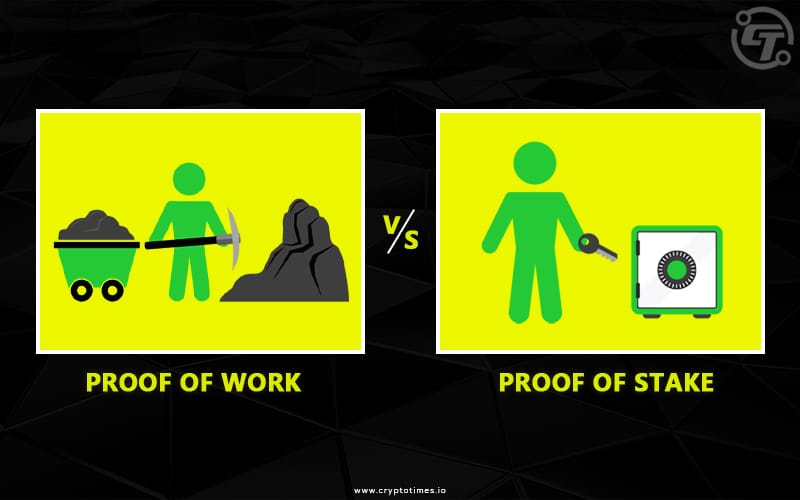You may often encounter sophisticated crypto terms such as Proof of Work (PoW) and Proof of Stake (PoS) consensus mechanisms. The system that helps accomplish secured transactions and the issuance of new tokens is known as consensus.
PoW and PoS are two robust consensus mechanisms that validate cryptocurrency transactions and add new blocks to the blockchain. If you are a crypto enthusiast, it is essential to know the difference between Proof of Work and Proof of Stake consensus mechanisms and how it is crucial for a cryptocurrency project.
PoW is the oldest mechanism compared to PoS. Bitcoin works on Proof of Work consensus, whereas Cardano and Solana use Proof of Stake. Ethereum is in the transmission stage from Proof of Work to Proof of Stake. There is a considerable difference between both PoS and PoW.
In this article, you will understand the difference between the two and how they are formulated to tackle the spamming and fraud issues associated with blockchain transactions
History of PoW and PoS
Proof of Work
The term Proof of Work was casted by Ari Juels and Markos Jacobsson in 1999. Cynthia Dwor and Money Naor initially introduced the concept of PoW in 1992 as a way to prevent DoS attacks. But Markos and Juels have presented an unambiguous explanation of Proof of Work.
According to the authors, Proof of work is a protocol by which one explains to the next person that he has spent specific energy resources solving a mathematical puzzle within a restricted time. The authors do not formally introduce Proof of Work as a consensus mechanism. However, they demonstrate that it can solve digital timing issues as well as protect software against spam.
Proof of Stake
In 2012, Scott Nadal and Sunny King came up with the idea of Proof of Stake in a paper written by them. The central aim of the new mechanism is to overcome issues associated with Proof of Work.
Sunny and Scott introduced Proof of Stake in a cryptocurrency called Peer Coin (2013). Along with PoS, they kept PoW parallelly in the system. After that, another crypto project named NXT implemented a pure form of Proof of Stake. Later in 2014, Pavel created Black coin with a simple protocol that includes all the functions of Proof of Stake.
Difference Between Proof of Work and Proof of Stake
1. Proof of Work
Working Consensus
A blockchain consists of transactions arranged in chronological order. Each transaction must be verified and added as a block to the chain. In PoW consensus, the initial block is hardcoded into the system. It cannot be modified or changed, and it does not depend on any previous block. Hence, the first block is named as the genesis block or Block 0. The second block added to the chain references the Genesis block. Each succeeding block depends on its previous block in the chain.
In PoW, Nodes validate transactions by solving a complex mathematical equation. This process is called mining. Participating nodes are denoted as minors, and the mining capacity depends on the computation power of participating nodes.
To produce new blocks, miners will compete to solve the puzzle. The one who generates the correct result in first will add the verified transaction block to the blockchain. PoW uses an application-specific integrated circuit (ASICS) for mining.
Mathematical puzzles involved in the mining process are incredibly complex. Minors will initially assign a string of pseudo-random numbers called a hash. The newly generated hash will combine with data in the block. The merged result will pass through a hash function computer.
If the output result matches predefined conditions set out by the protocol, it is a winning hash. After the complete verification, the miner will update the transaction to the blockchain. Winners will be rewarded with a predefined amount of crypto tokens by the respective network.
Energy Consumption in PoW
Proof of Work consumes enormous energy for validation purposes. Though state-of-the-art computer technologies and software systems are now tagged with less energy consumption, it is in no way useful for PoW.
Miners need twice the energy and financial cost to participate in the validation. Studies disclose that Bitcoin’s average annual energy consumption is 130 TWh, nearly equal to the yearly energy consumption of a mid-sized country.
Rewarding System of PoW
Miner rewards in PoW consensus are named Block rewards. A miner will receive a cryptocurrency token or fraction of cryptocurrency set by the project. Ceratin crypto projects will reduce the mining reward over time. The reduction aids in balancing the coin supply and helps the deflationary mechanism.
Advantages
Proof of Work is a stringent way of verifying blockchain transactions. High-valued cryptocurrencies like Bitcoin need a secured mechanism to verify their transaction. Because of the advanced processing power and intricacy of mathematical puzzles, it is challenging to attack or meddle with the process.
Proof of work ensures security from distributed denial of service attacks and restricts malicious user activities.
Disadvantages
The major disadvantage of Proof of Works is that it requires a massive amount of energy in the process. The system handles a limited number of transactions, which creates scaling problems.
There is a chance of a fine for the wrong action. Submission of invalid blocks or inaccurate information in the system will be penalized. The penalty is calculated as the sunk cost of energy, time, and computing power
2. Proof of Stake
Working Consensus
Proof of Stake was presented to eliminate the hassle of relying on energy-dependent work. It arrived as an alternative method known as stakes. Based on some predefined set of factors, PoS selects a node randomly. Nodes with an ample amount of coin in hand can only participate in the process.
The designated node has to verify the transaction validity within the block. After verification, the block will be submitted to the network for validation. Once validated it will be added to the blockchain. PoS uses a graphic processing unit for minting.
Participating nodes in Proof of Stake consensus are known as validators. Validating capacity is proportional to the stake in the network. Stakers who staked more coins in a contract and held for a longer time will have a good opportunity of being selected as a validator. Stakers must stake a minimum amount of coins to participate in the validation process. Participating nodes must be confident enough to validate the transaction.
Similar to Proof of Work, the initial block in PoS is called the genesis block. The subsequent blocks will refer to the previously added blocks in the system. The exact process differs from one project to another. Instead of mining, the procedure is called staking. Mined Proof of Stake blocks is called ‘forged or minted’ blocks.
Energy Consumption in PoS
Proof of Stake does not depend on computing power and energy consumption to select a node for transaction verification. Rather than competing, the process asks an individual to develop a new block. Hence it consumes less electricity for the entire process.
Rewarding in PoS
Validators in Proof of Stake are incentivized for the successful validation of the block. They will receive the transaction fees as compensation for the network contribution in most cases. PoS is rewarding for the one who invested the most in a respective crypto token, provided they should verify the transaction accurately.
Advantages
Reduced electricity consumption is one of the significant benefits of Proof of Stake. It demands less amount of energy to produce an ample number of coins. Smart contracts and DeFi service projects require higher scalability and lesser gas fees.
Ethereum, the most extensive smart contract and DeFi platform, uses Proof of Work consensus and has high gas fees. To increase the scalability and reduce gas fees, Ethereum decided to transfer from PoW to PoS.
Also Read: All about the Ethereum Merge
Proof of Stake leverages the advantages of scalability and energy efficiency. Users need not be technology experts to participate in the minting process. Moreover, it eliminates high-end hardware systems and tries to keep the process efficient.
Disadvantages
Validators who accept bad blocks or pass an incomplete verification process will be penalized. A part of their staked fund will be taken as a penalty.
PoS supports the wealthier user. The probability of participation depends on the number of token users staked. So those who own a good amount of tokens will often get the chance to become a validator and receive a reward.
Conclusion:
Proof of Work leans on the cost of electricity it burns to prevent the system from potential hackers. At the same time, Proof of Stake relies on direct economic incentives. A notable difference is in the scalability issue and energy consumption.
Bitcoin that works on Proof of Work consensus conducts only five transactions per second. A single BTC transaction can burn more than 750 kWh of energy. On the same side, Ethereum handles fifteen transactions per second with approximately 60 kWh energy. As a result, networks that rely on PoW have been compelled to set an increased gas fee.
Cryptocurrency projects operate on Proof of Stake consensus characterized by high TPS, less energy consumption, and reduced gas fees. For instance, Solana can possess fifty thousand transactions per second with an energy consumption of 0.166 kWh per transaction. Cardano handles more than 250 transactions per second with an energy consumption of 0.5479 KWh.
Nevertheless, technocrats have a different opinion about the security concern of PoS and PoW. Proof of Work is more complicated and requires higher computational capacity. Therefore, it is less exposed to spamming or fraud issues.
PoS is less complex, but that doesn’t mean it is easy to hack. PoS projects take other security measures to ensure transaction safety. Someone needs to hold 51% of a cryptocurrency for an attack, which is improbable. So, both mechanisms ensure their security measures for working.
For eco-conscious traders looking to navigate the evolving crypto investment landscape responsibly, platforms like Immediate Turbo are emerging as a responsible choice. These platforms provide a sustainable approach to cryptocurrency trading, aligning with the growing awareness of environmental concerns in the crypto space.”







